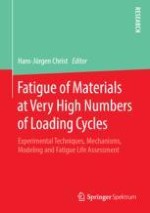2018 | OriginalPaper | Buchkapitel
Fatigue mechanism and its modeling of an austenitic-ferritic duplex stainless steel under HCF and VHCF loading conditions
verfasst von : B. Dönges, Claus-Peter Fritzen, Hans-Jürgen Christ
Erschienen in: Fatigue of Materials at Very High Numbers of Loading Cycles
Verlag: Springer Fachmedien Wiesbaden
Aktivieren Sie unsere intelligente Suche, um passende Fachinhalte oder Patente zu finden.
Wählen Sie Textabschnitte aus um mit Künstlicher Intelligenz passenden Patente zu finden. powered by
Markieren Sie Textabschnitte, um KI-gestützt weitere passende Inhalte zu finden. powered by
By means of high frequency (about 20 kHz) fatigue testing techniques, the fatigue behavior of an austenitic-ferritic duplex stainless steel was experimentally investigated up to one billion load cycles. Additional fatigue tests were performed by means of conventional fatigue testing techniques at 30 Hz in order to characterize the influence of the strain rate on the obtained fatigue data. The fatigue lives are shifted to higher numbers of load cycles with increasing testing frequency or strain rates, whereas the fatigue limit and the mechanisms of fatigue crack initiation are not affected. The present study documents, that at low loading amplitudes and very high numbers of loading cycles fatigue damage in form of slip bands predominantly occurs in the softer austenitic phase, whereas crack initiation takes place at intersection points between austenite slip traces and phase boundaries in neighboring ferritic grains. Some of these fatigue cracks are able to grow further – others are not. The stress distribution on the grain scale and crystallographic misorientations at grain or phase boundaries may inhibit the ongoing of fatigue damage in form of crack propagation, leading to a real fatigue damage despite the presence of short fatigue cracks. The experimentally identified mechanisms of fatigue crack nucleation and short fatigue crack propagation were implemented into crystal plasticity finite element simulations by applying a fatigue damage parameter, which was derived from traditional mechanism based fatigue models. When a material specific threshold value is achieved, damage manifests itself by a loss of stiffness of the respective finite elements. Furthermore, anisotropic elasticity as well as first and second order residual stresses due to the manufacturing process of the investigated material were considered. The simulation results were verified by means of a comparison with real observed fatigue cracks. The current investigation clearly shows the relevance of the consideration of 3D-grain-shapes and residual stresses for the accuracy of the simulation results, which are the basis for a fatigue life assessment concept.
